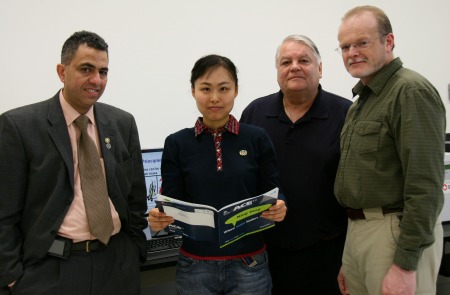
Engineering professor Mohamed Gamal El-Din, PhD student Ning Ding and microbiology professors Mike Belosevic and Norman Neumann have discovered a new way to destroy prions-the culprits behind infectious disease like Alzheimer's and Mad Cow disease.
Edmonton-A University of Alberta research team has devised a technique to destroy misfolded proteins preventing the transmission of infectious disease like Mad Cow disease.
Microbiology professors Mike Belosevic and Norman Neumann and engineering professor Mohamed Gamal El-Din have demonstrated for the first time that misfolded proteins (called prions) are highly susceptible to water treated with ozone. The discovery could have applications in decontaminating surgical instruments or treating waste water in settings where prions might appear, such as at slaughterhouses.
Their research appears in the journal Applied and Environmental Microbiology. The lead author of the paper is Ning Ding, a PhD student in Civil and environmental engineering being supervised by Gamal El-Din and Belosevic. She is working on her PhD, focusing on waste water disinfection.
Prions have been identified as the culprits behind Mad Cow disease and Chronic Wasting disease in animals and their human variants, Creutzfeld-Jakob disease and Alzheimer's disease. Prions are found in the brain and spinal cord tissue of infected animals and are a grave health risk in human and animal settings.
Cases of human transmission through surgical equipment have been documented. The U of A research team's technique of using water treated with ozone to destroy prions is an improvement on current prion decontamination methods.
"Even after incinerating prions at 850 C they are still infectious," Neumann said. "We have observed that ozone appears to be capable of readily destroying these infectious proteins, which means there might be simple solutions to dealing with contaminated medical instruments and waste products from slaughter houses."
Belosevic says the team was inspired by existing technology. "This technology is already used for water treatment and waste water treatment," he said. "So this is easily scaled up-we don't have to re-invent the wheel."
Gamal El-Din says the research "puts us on the right track" to develop more efficient ozone contact systems. "We have the expertise in microbiology and engineering to make a difference. The ultimate goal is the protection of public health and safety and to protect the environment."